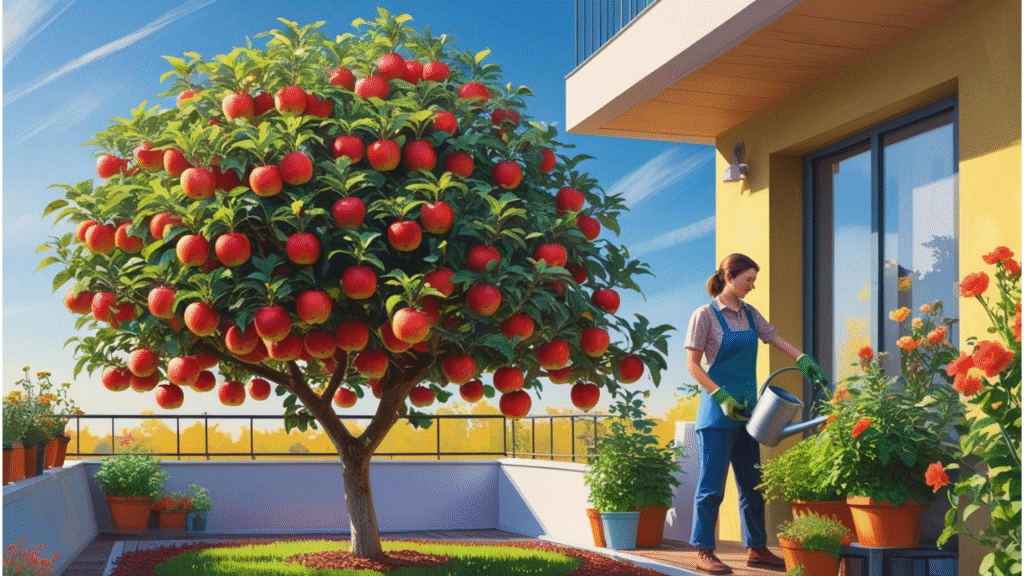
How to Grow Healthy Dwarf Apple Trees: Expert Tips for Small Spaces and Big Yields
Are you dreaming of fresh apples right from your backyard, but think you don’t have enough space? 🍏 You’re not alone! Many gardeners are discovering the benefits of growing dwarf apple trees, which are perfect for small spaces like balconies, patios, or even urban gardens. These compact trees may be small in size, but they pack a punch when it comes to producing delicious, homegrown fruit.
The challenge? Growing a healthy dwarf apple tree requires more than just planting it and hoping for the best. Without the right care and knowledge, you might end up with a tree that doesn’t thrive or produce fruit. But don’t worry—this guide is packed with expert tips and practical advice to help you grow vibrant, fruitful dwarf apple trees, no matter how limited your space is. Keep reading to unlock the secrets to achieving a bountiful apple harvest in your very own garden! 🌳✨
Table of Contents
Toggle😊 Why Choose Dwarf Apple Trees for Your Garden? 🍏
If you’re working with limited space but still want to enjoy fresh, homegrown apples 🍏, dwarf apple trees are a perfect solution! These compact trees 🌳 are designed to thrive in smaller areas, making them ideal for gardens, patios, or even balconies 🏙️. But what makes dwarf apple trees so special? Let’s dive into the key reasons why you should consider adding one (or more!) to your garden. 🌱
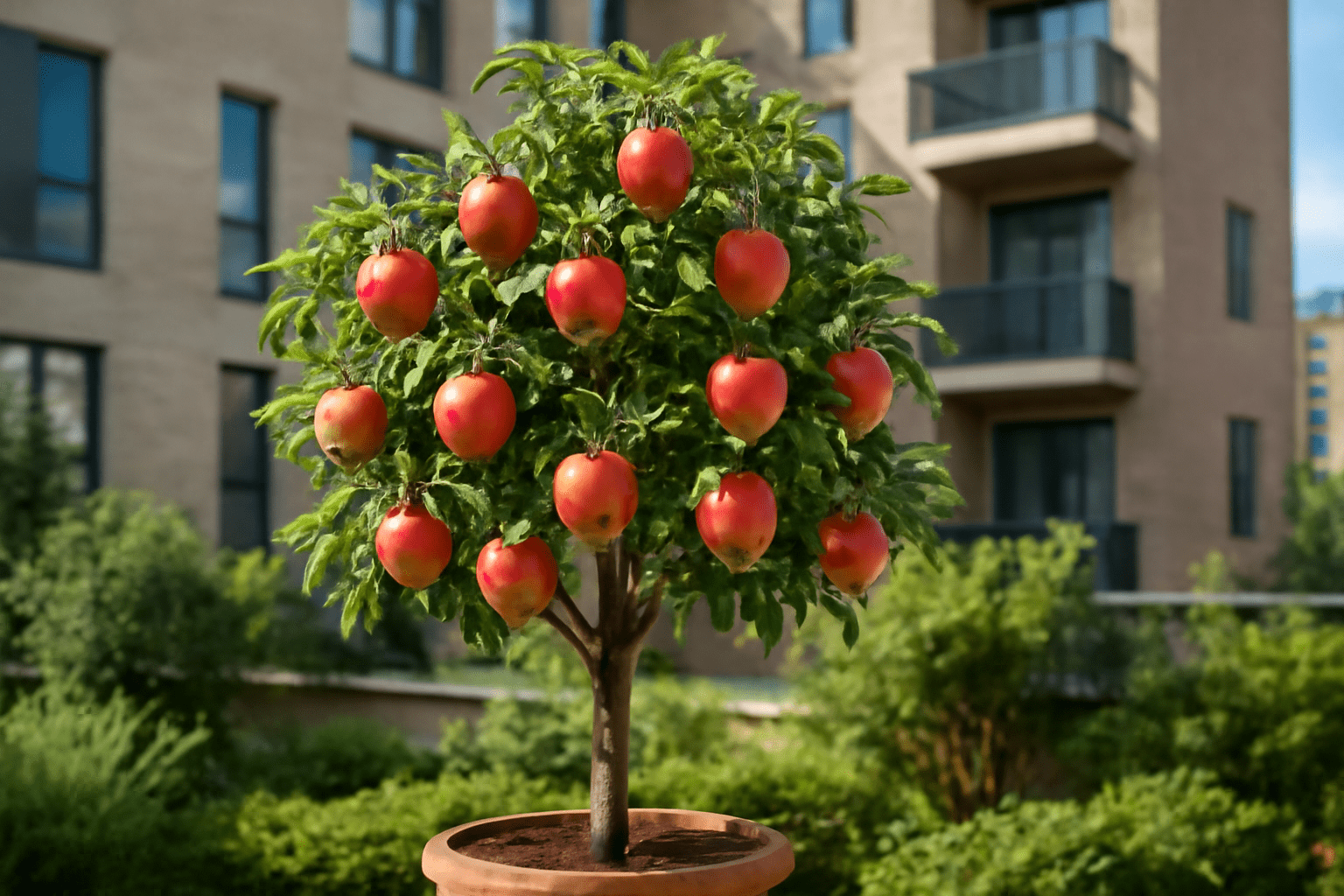
🌟 Space-Saving Solution 🌟
Dwarf apple trees are significantly smaller than their standard counterparts 🌳, typically growing to just 6-8 feet tall. This makes them ideal for small gardens or even urban spaces 🏙️ where traditional apple trees just won’t fit. Whether you have a tiny backyard 🌱 or a cozy balcony, you can still enjoy the benefits of homegrown apples! 🍏
🍎 Faster Fruiting 🍎
One of the biggest advantages of dwarf apple trees is their quicker fruiting time ⏳. While standard apple trees may take 4-6 years to bear fruit 🍏, dwarf varieties often start producing in just 2-3 years! That means you’ll be harvesting delicious apples 🍎 much sooner. Perfect for impatient gardeners! 🌿
🌞 Easy to Maintain 🌞
Dwarf apple trees are much easier to care for due to their manageable size 🌱. Pruning ✂️, harvesting 🍏, and general maintenance 🧑🌾 are simpler tasks, especially for beginners. Plus, smaller trees require less water 💧 and fertilizer 💚 compared to their larger counterparts, making them more low-maintenance. 🌿
🏠 Great for Urban and Small Spaces 🏠
Living in the city 🏙️ or in a place with limited outdoor space? No problem! Dwarf apple trees 🌳 are well-suited for containers 🪴, so they can thrive on patios, balconies 🏢, or even windowsills 🪟. They’re a great way to bring a bit of nature 🌳 and fresh fruit 🍎 to your urban life.
🍏 Surprisingly High Yields 🍏
Although smaller in stature, dwarf apple trees 🌳 can still provide a generous harvest 🍏. With proper care 🌱, these trees can yield a good amount of apples 🍎, perfect for fresh eating, baking 🍰, or even making homemade cider 🍻. Talk about a space-efficient crop! 🥧
By choosing dwarf apple trees 🌳, you’re not just saving space—you’re also getting faster results ⏳, easier maintenance 🌿, and a productive harvest 🍏 in a small area. Ready to plant your own tree? Keep reading 📚 for expert tips 🧑🌾 on how to care for your dwarf apple tree and enjoy a fruitful garden year after year! 🌳🍏
🍏 Choosing the Right Dwarf Apple Tree Variety 🌳
When it comes to growing dwarf apple trees 🌳, selecting the right variety is key to ensuring your tree thrives and produces delicious fruit 🍏. Not all dwarf apple trees are created equal, so it’s important to choose a variety that suits your space, climate, and taste preferences 🍎. Let’s explore the best dwarf apple tree varieties for beginners and the key factors you should consider when making your choice. 🌱
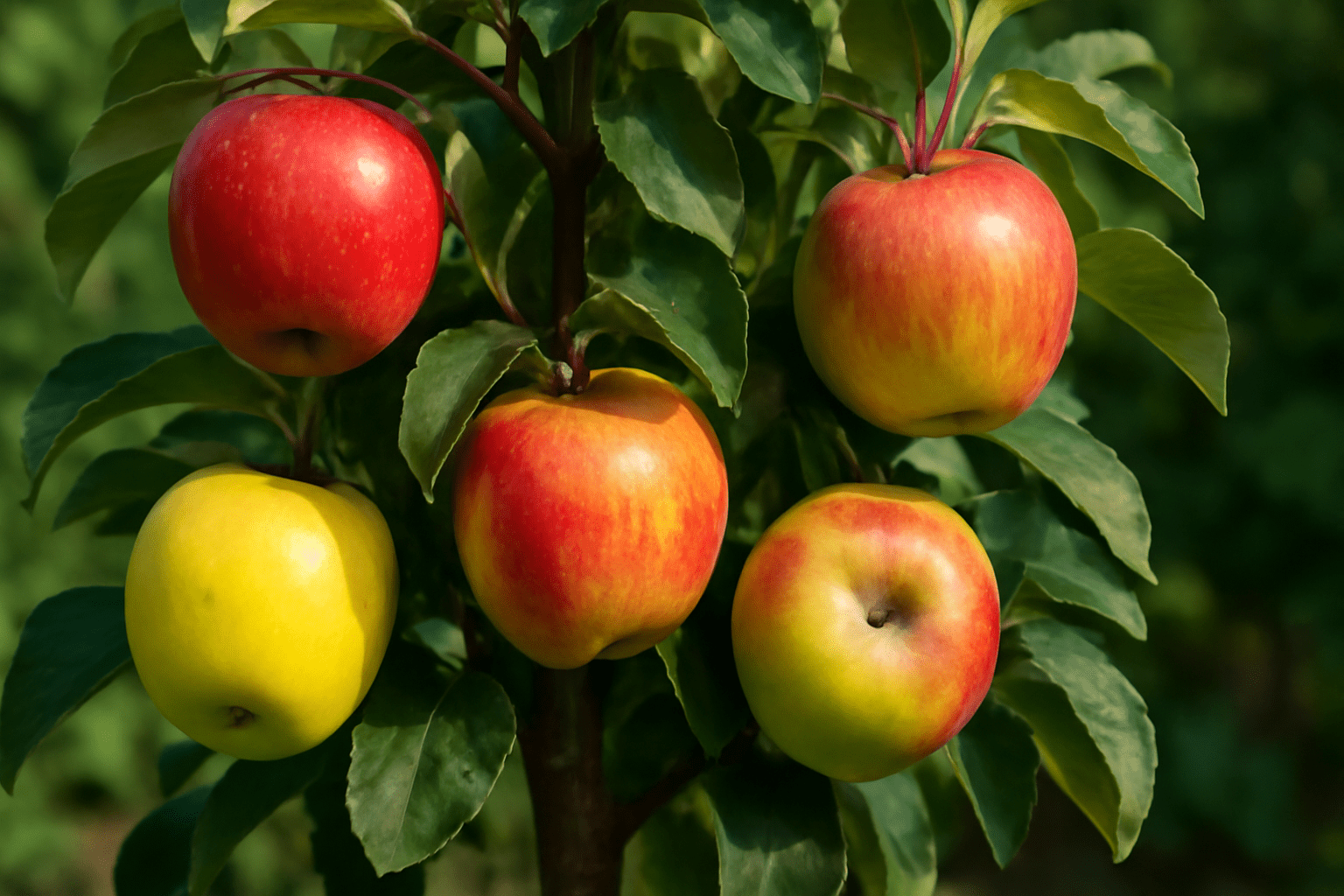
🍏 Best Dwarf Apple Tree Varieties for Beginners 🌟
🌿 M9 Rootstock 🌿
The M9 rootstock is one of the most popular choices for small spaces 🏙️. These trees typically grow to a manageable height of 6–8 feet 🌳, making them perfect for gardens, patios 🏡, or even container planting 🪴. They’re known for their vigorous growth 🌱, high yields 🍏, and quick fruiting 🍎, making them ideal for first-time apple tree growers 🌟.
🍏 Apple ‘Pixie’ 🍏
If you’re looking for a compact tree 🌳 that produces sweet, small apples 🍏, the ‘Pixie’ variety is an excellent choice. This tree is especially well-suited for tight spaces 🏙️, and its fruit is perfect for fresh eating, pies 🥧, and cider 🍻. Despite its small size, the ‘Pixie’ is highly productive, providing a good harvest in just a few years 🍏✨.
🍎 Apple ‘Golden Delicious’ Dwarf 🍎
The dwarf version of the popular ‘Golden Delicious’ apple tree 🍏 offers the same sweet, crisp apples 🍎 but in a much smaller form. It typically grows to around 6–8 feet tall 🌳, making it perfect for small spaces. This variety is known for its disease resistance 🦠 and is an excellent choice for beginner gardeners 🌱 who want a reliable, easy-to-care-for tree 🍏.
🍏 Factors to Consider When Choosing a Dwarf Apple Tree Variety 🧐
🌞 Climate Compatibility 🌞
Not all apple trees 🌳 are suited to every climate 🌦️, so it’s essential to pick a variety that thrives in your USDA hardiness zone 🌍. Whether you live in a cold ❄️ or mild climate 🌞, check the specific temperature tolerance of the variety you’re interested in to ensure it will flourish in your region.
🌸 Pollination Needs 🌸
Some dwarf apple trees 🌳 are self-pollinating 🍏, meaning they don’t need another tree nearby to bear fruit 🍎. However, many varieties, like the ‘Golden Delicious’ 🍏, require cross-pollination for optimal yields 🌱. If you have limited space for multiple trees 🌳, look for self-pollinating options, or ensure you plant compatible trees nearby for successful pollination 🌸.
🥧 Flavor and Uses 🥧
Consider what you’ll use the apples 🍏 for. Do you want them fresh off the tree 🌳, or are you planning to use them for baking 🍰, cooking 🍲, or making cider 🍻? Different varieties offer distinct flavors, from sweet 🍯 to tart 🍋. Picking the right variety for your desired use ensures you get the most out of your harvest 🍎.
Choosing the right dwarf apple tree variety for your garden 🌱 is about more than just size—it’s about selecting a tree 🌳 that suits your climate 🌞, space 🏡, and preferences 🍏. With the right variety, you’ll be on your way to growing a productive, flavorful apple tree 🍏 in no time! 🌳🍏
🍏 How to Plant Dwarf Apple Trees 🌳
Planting your dwarf apple tree 🌳 correctly is crucial for its health and successful growth. By following these simple steps 📝, you’ll ensure that your tree gets the best start and thrives in your garden or container 🏡. Here’s a step-by-step guide to planting your dwarf apple tree 🌱 the right way.
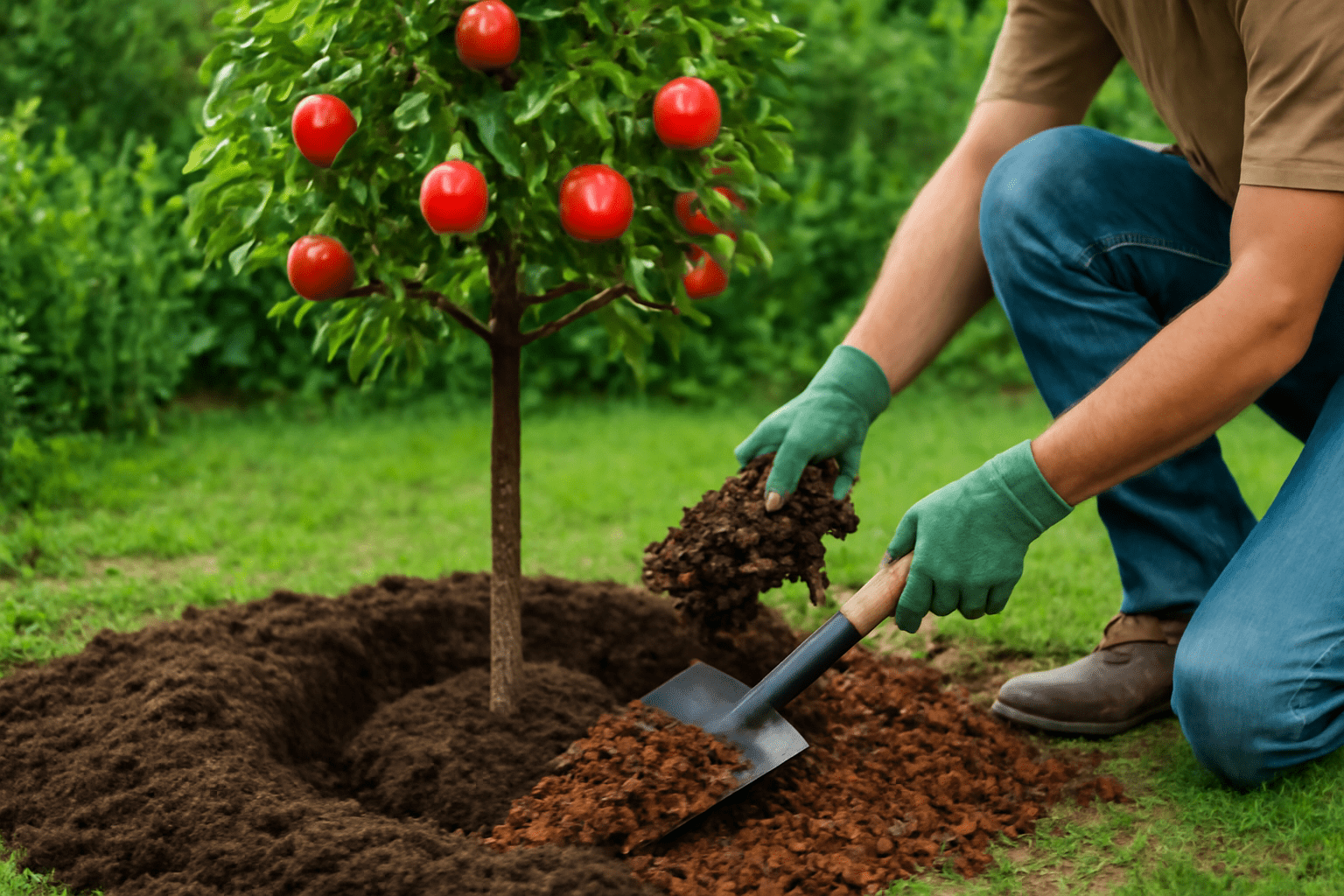
🌞 Choosing the Right Spot 🌞
- Full Sunlight: Dwarf apple trees 🌳 need plenty of sunlight ☀️ to grow strong and healthy. Make sure your tree gets at least 6-8 hours of direct sunlight each day. The more sunlight 🌞, the better your tree will thrive and produce fruit 🍏.
- Well-Drained Soil: Apple trees 🌱 don’t like soggy roots 🦶, so choose a location with well-drained soil 🌿. The ideal soil pH for dwarf apple trees is between 6.0 and 7.0. You can test the soil pH with a simple home testing kit available at most garden centers 🏬.
- Space Between Trees: Even though dwarf apple trees 🌳 are smaller, they still need enough space to grow properly. Make sure there is adequate spacing between trees 🌳—ideally 2-3 feet apart—to allow for air circulation 🌬️ and prevent overcrowding. Fresh air helps reduce the risk of diseases 🦠.
🌱 Planting Process 🌱
- Dig the Hole: Start by digging a hole ⛏️ that’s twice the width of the root ball. The hole should be deep enough so that the root collar (where the roots meet the trunk) is level with the soil surface 🌍. This ensures proper root development.
- Place the Tree: Gently place the tree 🌳 in the hole, making sure the roots are spread out evenly. Check that the root collar is not buried too deep—don’t plant too deep as it can suffocate the roots 🛑.
- Backfill with Soil: Once the tree 🌳 is positioned, backfill the hole with soil 🌱, making sure the tree is straight. Press down gently to remove any air pockets 🌬️. Water the tree 💧 thoroughly after planting to help the soil settle around the roots 🦶.
- Mulch the Base: Apply a 2-3 inch layer of mulch 🌾 around the base of the tree 🌳, making sure it doesn’t touch the trunk. Mulch helps retain moisture 💦, regulate soil temperature 🌡️, and prevent weeds 🌿 from growing.
💧 Watering Tips 💧
- Regular Watering: After planting 🌱, it’s important to water your dwarf apple tree regularly until it’s established. The soil should stay moist 💧, but not waterlogged 🏞️. A deep watering once a week is generally enough unless you’re in a particularly dry climate 🌵.
- Avoid Overwatering: Too much water 💦 can lead to root rot 🦠, so always check the soil moisture 🌱 before watering. If the soil feels moist, hold off on watering for a few days 🌊.
📌 Key Tips for Success 📌
- Don’t Plant Too Deep: Ensure the roots 🦶 are not buried too deep. Planting too deep can lead to poor air circulation 🌀 around the roots and stunt growth 🛑.
- Mulch Around the Base: A layer of mulch 🌿 around the tree 🌳 helps keep the soil moist, protects roots from extreme temperatures 🌡️, and reduces weed growth 🌱.
By following these simple planting steps 🌱, you’ll set your dwarf apple tree 🌳 up for success. Whether you’re planting in the ground 🌍 or a container 🪴, a little extra care in the planting process will pay off in the long run with healthy growth 🌿 and delicious fruit 🍏!
🍏 Care and Maintenance of Dwarf Apple Trees 🌳
To ensure your dwarf apple tree 🌳 grows healthy and produces a bountiful harvest 🍏, regular care and maintenance are essential. From watering 💧 to pruning ✂️, here are the key tips to keep your tree thriving year after year. 🌿
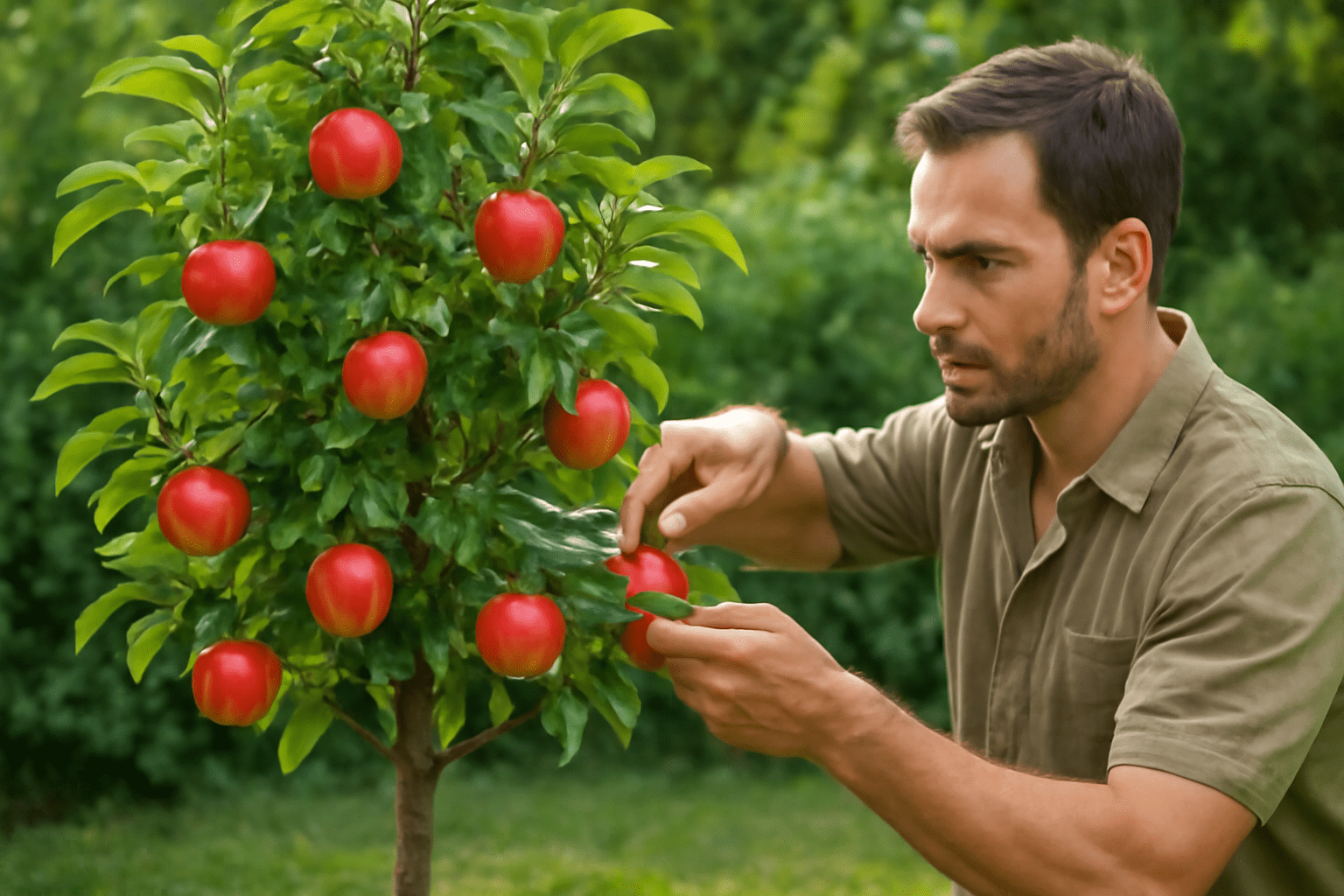
💧 Watering Tips for Dwarf Apple Trees 💧
🌊 Keep the Soil Moist 🌊
Dwarf apple trees 🌳 need consistently moist soil 💧, but they don’t like to sit in water 💦. Ensure the soil is kept moist, but never soggy. Water the tree thoroughly until the water drains from the bottom of the pot 🪴 (if planted in a container).
🌞 Water Regularly, Especially During Dry Periods 🌞
During hot or dry spells 🌡️, it’s important to water your dwarf apple tree 🌳 more frequently. Deep watering once a week is typically enough. Avoid shallow watering, as it can encourage shallow root growth 🦶.
🌱 Fertilizing Your Dwarf Apple Tree 🌱
🍏 Use a Balanced Fertilizer (10-10-10) 🍏
In early spring 🌷, before new growth starts 🌱, apply a balanced, slow-release fertilizer like 10-10-10. This will provide essential nutrients 💪 to kickstart your tree’s growth 🌳. Fertilize again in late summer 🍂 to support fruit production 🍏.
❄️ Avoid Fall Fertilizing ❄️
Avoid fertilizing in the fall 🍂, as it can encourage new growth 🌱 that may not have time to harden off before the colder weather arrives 🥶. Excess growth in the fall can also make the tree more vulnerable to winter damage ❄️.
✂️ Pruning Dwarf Apple Trees ✂️
🌿 Prune Annually for Health 🌿
Pruning ✂️ is key to maintaining the shape and health of your tree 🌳. Prune annually in late winter ❄️ or early spring 🌸 when the tree is dormant. Remove any dead, diseased, or damaged branches to prevent the spread of disease 🦠 and promote healthy growth.
🌬️ Open the Canopy 🌬️
Focus on thinning the canopy by removing crowded branches 🌳. This will improve airflow 🌬️ and allow sunlight 🌞 to reach more parts of the tree, ensuring better fruit development 🍏 and reducing the risk of fungal diseases 🦠.
🌾 Mulching for Moisture and Protection 🌾
🌱 Apply Mulch in Spring 🌱
Mulch around the base of your dwarf apple tree 🌳 helps conserve moisture 💧, reduce weeds 🌿, and regulate soil temperature 🌡️. Apply a 2-3 inch layer of mulch (such as wood chips 🌲 or straw) in the spring 🌷, but make sure it doesn’t touch the tree’s trunk to avoid moisture buildup that could cause rot 🦠.
❓ FAQs: ❓
- How often should I water my dwarf apple tree?
Water your tree deeply once a week 🌊, especially during dry spells 🌞. Always check the soil moisture before watering 💧 to avoid overwatering. - When is the best time to prune my dwarf apple tree?
Prune your tree in late winter ❄️ or early spring 🌱 while it’s still dormant. This helps shape the tree 🌳 and removes any dead or diseased wood 🪵. - How do I know if my tree needs fertilizer?
If your tree 🌳 isn’t growing as vigorously or producing as much fruit 🍏, it may be lacking nutrients. Fertilize in early spring 🌷 and late summer 🍂, but avoid fertilizing in the fall 🍁.
By following these essential care tips 🌱, you’ll ensure your dwarf apple tree 🌳 stays healthy 💚, strong 💪, and productive 🍏 throughout the year. With just a little attention and care 💧, you’ll enjoy a thriving apple tree 🍏 in no time! 🌳🍏
🍏 Pollination and Fruit Production 🌳
One of the most exciting aspects of growing dwarf apple trees 🌳 is the promise of fresh, homegrown apples 🍏. However, to get the best harvest, it’s essential to ensure proper pollination 🐝. Let’s dive into the pollination process and how you can encourage successful fruit production for bigger, better yields! 🍎
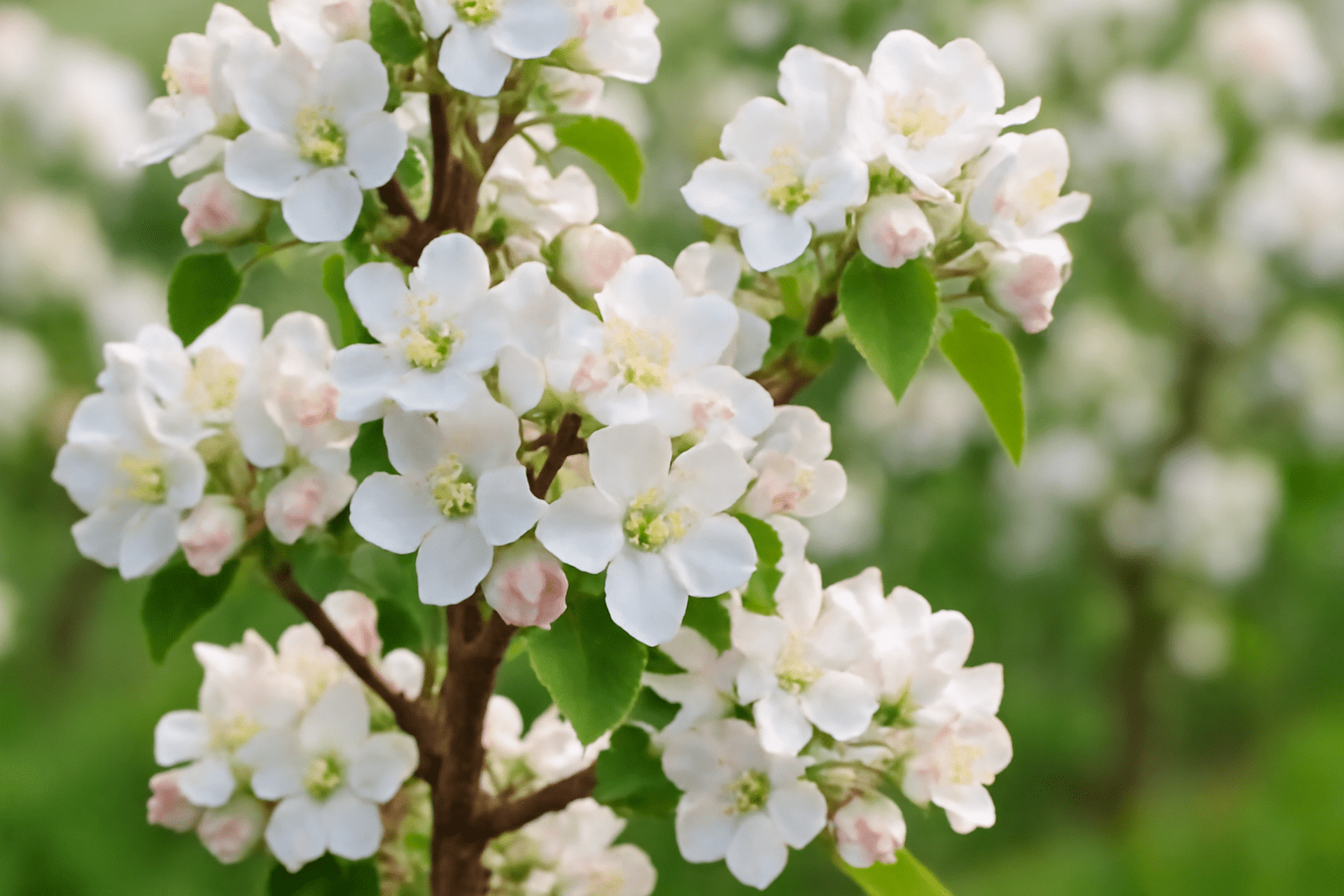
🌸 Pollination Requirements 🌸
🍏 Self-Pollinating vs. Cross-Pollinating 🍏
Some dwarf apple trees 🌳 are self-pollinating, meaning they can produce fruit without needing another tree nearby 🌱. However, many varieties still benefit from cross-pollination 🌸, which involves having a different apple tree nearby to increase fruit yield 🍏 and quality 🍎.
🌿 Cross-Pollination for Bigger Yields 🌿
While self-pollinating trees 🌳 can produce fruit 🍏, cross-pollination often results in larger and more consistent crops 🌳. Cross-pollinating trees help ensure that flowers 🌸 receive pollen from a compatible variety, leading to more apples per tree 🍏.
🐝 How to Encourage Pollination 🐝
🌸🍏 Plant Different Apple Tree Varieties Close By 🌸🍏
To maximize pollination 🌿 and fruit yield 🍎, plant at least two different apple varieties nearby 🌳. This allows them to cross-pollinate effectively. Choose varieties that bloom at the same time ⏰ for the best results. 🌸🍏
🌻 Use Pollination Aids 🌻
If you don’t have space for more than one tree 🌳, you can encourage pollination with a few creative solutions 💡. Bees 🐝 are natural pollinators, so ensure your garden attracts them by planting flowers 🌻 nearby. Alternatively, you can use a hand pollination kit 🧑🌾 to manually transfer pollen between flowers 🌸. This method is especially helpful in areas with limited pollinators 🐝.
🍎 When to Expect Fruit 🍎
⏳ Time to Fruit Production ⏳
Most dwarf apple trees 🌳 will begin producing fruit 🍏 in 2–3 years 🌱. This is much quicker than standard apple trees 🌳, which can take 4-6 years or longer. Patience ⏳ is key, but with proper care and pollination 🐝, you’ll enjoy your first harvest 🍎 sooner than you think! 🌳🍏
Pollination plays a critical role in the success of your dwarf apple tree 🌳. By understanding whether your tree 🌳 is self-pollinating or needs a second tree 🌱, and encouraging pollination through planting strategies 🌿 or pollinator aids 🐝, you’ll ensure a healthy, productive apple tree 🍏. Before you know it, your tree 🌳 will be laden with delicious apples 🍏, ready for harvest! 🍏🌳
🍏 Common Pests and Diseases to Watch Out For 🌳
Just like any fruit tree 🌳, your dwarf apple tree 🍏 can face a few challenges from pests 🐛 and diseases 🦠. However, with the right preventive measures, you can keep your tree healthy 🌿 and thriving 🌱. Here’s how to protect your dwarf apple tree 🌳 from the most common pests 🐛 and diseases 🦠! 🍎

🐛 Common Pests 🐛
🍏 Aphids 🍏
Aphids are small, soft-bodied insects 🦗 that suck the sap from your apple tree’s leaves 🍏, causing them to curl and yellow. These pests can also spread diseases 🦠.
- Solution: Use organic insecticidal soap 🧴 or neem oil 🌿 to control aphid infestations safely.
🍎 Apple Maggots 🍎
Apple maggots are a common pest 🐛 that causes damage to apples 🍏 by laying eggs inside the fruit. The larvae 🐞 then feed on the apple’s flesh 🍎, making it unsuitable for consumption.
- Solution: Use sticky traps 🧩 around the tree 🌳 or apply neem oil 🌿 to deter the adult flies 🦋 from laying eggs.
🍏 Codling Moths 🍏
These moths 🦋 are known to burrow into apples 🍏 and cause internal damage 🦠. The larvae of codling moths can ruin the fruit, often before you even see it.
- Solution: Hang pheromone traps 🪤 to attract and catch the male moths 🦋, or use insecticidal soap 🧴 to manage infestations.
🌱 Common Diseases 🌱
🌿 Powdery Mildew 🌿
Powdery mildew appears as white, powdery spots on leaves 🍃, stems 🌿, and buds 🌸, and can weaken the tree 🌳, stunting growth.
- Solution: Ensure proper air circulation 🌬️ around your tree 🌳 and treat with fungicide or horticultural oil 🌱 at the first sign of infection.
🍏 Apple Scab 🍏
Apple scab causes dark, scabby spots on the leaves 🍃 and fruit 🍎, which can affect the tree’s health 🌳 and reduce the quality of apples 🍏.
- Solution: Plant disease-resistant varieties 🌳 and remove any infected leaves 🍂 or fruit 🍏. Applying fungicides during the early spring 🌱 can also help prevent this disease.
🛡️ Preventive Measures 🛡️
🔍 Regularly Inspect for Pests and Diseases 🔍
Regularly check your tree 🌳 for any signs of pests 🐛 or diseases 🦠. Early detection 🕵️♂️ is key to stopping infestations before they get out of hand. Look for unusual spots, holes in leaves 🍃, or visible insects 🦗 on the tree 🌳.
🌿 Use Horticultural Oils or Sprays 🌿
Preventive treatments like horticultural oils 🌱 or neem oil 🌿 can be used throughout the growing season 🌞 to protect your tree 🌳 from pests 🐛 and diseases 🦠. These oils are safe and effective, especially if used early in the season 🍂 before infestations occur.
📌 Bullet Points for Protection 📌
- Ensure Good Air Circulation: Proper spacing between trees 🌳 and regular pruning ✂️ will help air flow around the branches 🌿, reducing the risk of fungal diseases like powdery mildew 🌱.
- Inspect Regularly for Pests: Regularly check your tree 🌳 for signs of pest damage 🐛 or disease 🦠—early detection leads to easier control. A proactive approach is the best way to prevent serious damage 🛠️.
By staying vigilant 👀 and following these preventive measures, you can protect your dwarf apple tree 🌳 from pests 🐛 and diseases 🦠 and ensure a healthy 🌿, productive tree 🍏. With a little care and attention, your tree 🌳 will thrive 🌱 and reward you with delicious fruit 🍏! 🌳
🍏 Harvesting and Enjoying Your Dwarf Apple Trees 🌳
The moment you’ve been waiting for is finally here: it’s time to harvest your homegrown apples 🍏! Knowing when and how to harvest your dwarf apple tree 🌳 is crucial to enjoying the best flavor and texture 🍎. Let’s explore the steps to harvest and make the most of your delicious, homegrown apples. 🌱
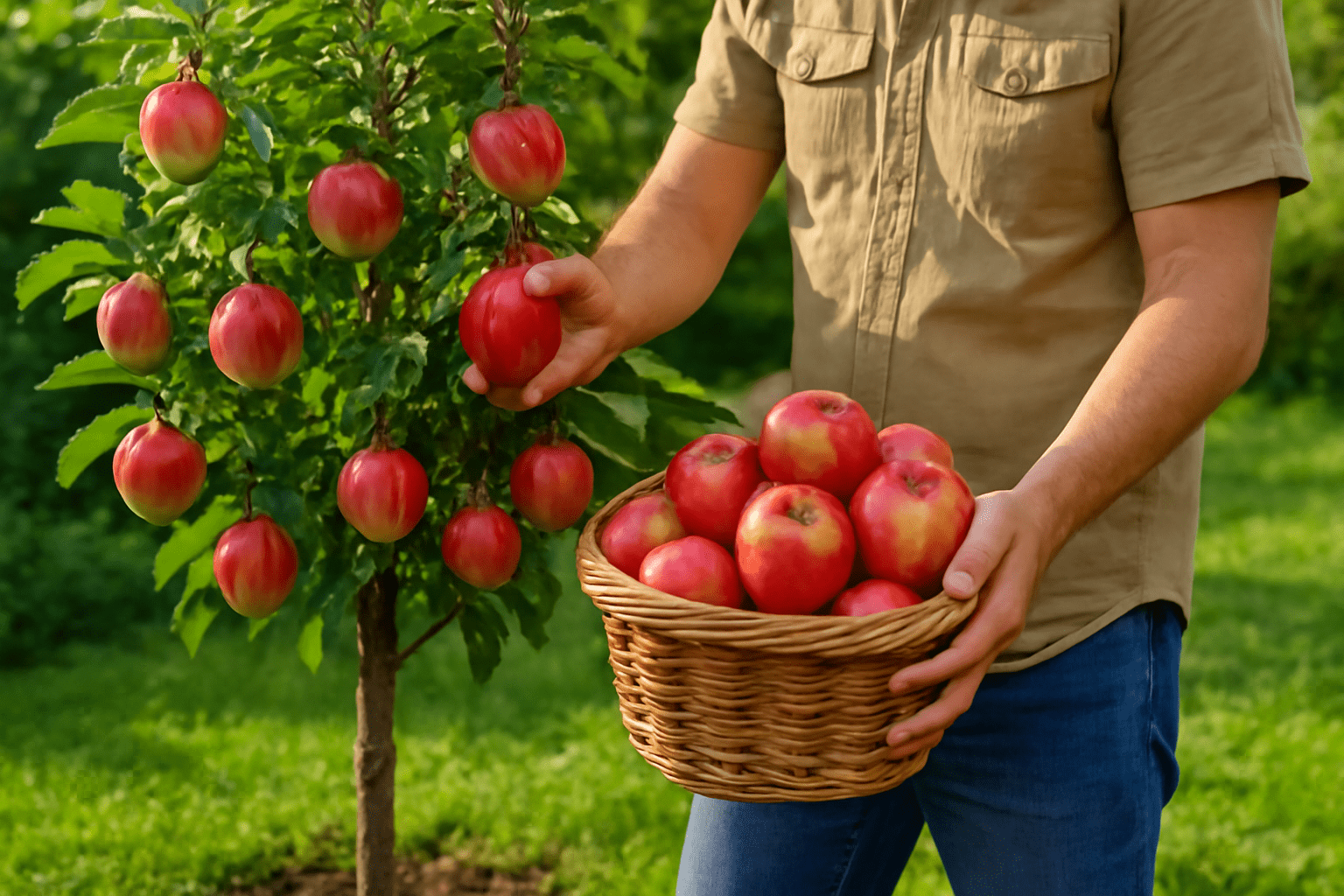
🍏 When to Harvest Dwarf Apples 🍏
🌱 Look for Ripeness 🌱
The key to harvesting apples 🍏 at their peak flavor is timing ⏰. Most dwarf apple trees 🌳 will bear fruit in 2-3 years 🌱, but apples 🍎 should only be harvested when they’re fully ripe. Here’s what to look for:
- Color: Apples 🍏 should have their characteristic color 🌈 (e.g., red 🍎 for red varieties or yellow 🍏 for golden types).
- Firmness: Gently squeeze the apple 🍏. It should feel firm 💪 but not hard. If it gives slightly, it’s ready to pick 🍎.
- Ease of Picking: A ripe apple 🍏 will come off the tree 🌳 with a gentle twist. If you need to pull too hard, it’s not quite ready.
🌞 Time of Day 🌞
The best time to harvest 🍏 is in the morning 🌅 when the apples are cool 🌬️. This helps preserve their crispness 🥶 and prevents bruising. It’s also easier to spot ripe apples 🍏 when they haven’t been exposed to the afternoon heat 🌞.
🍎 How to Harvest Apples 🍎
🌳 Use Proper Techniques 🌳
To avoid damaging your tree 🌳, don’t pull too hard on the apples 🍏. Instead, gently lift the apple 🍏 upwards and give it a slight twist. If it’s ripe, it will come off the branch 🌿 with ease. If you’re harvesting a lot of apples 🍏, consider using harvesting poles to reach high branches without damaging the tree 🌳.
🧺 Handle with Care 🧺
Apples 🍏 are delicate! After picking, handle them gently 👐 to avoid bruising. Place them in a soft, padded container 🧺 to protect them during transport 🚶. If you’re picking in large quantities, use a soft cloth or a cushioned basket 🧺 for better protection.
🍏 Storing and Enjoying Your Apples 🍏
❄️ Storing Fresh Apples ❄️
Freshly harvested apples 🍏 should be stored in a cool, dry place 🌬️. If you have a basement 🏠 or a cool pantry 🥶, that’s ideal. Most apples 🍎 will stay fresh for 2-3 weeks 🗓️. If you want them to last longer, place them in the refrigerator ❄️. Some apple varieties 🍏, like ‘Fuji’ 🍎 and ‘Granny Smith’ 🍏, keep for months if stored properly.
🍏 Long-Term Storage 🍏
For long-term storage, you can freeze ❄️ or can your apples 🍏. Slice them 🍎, treat them with lemon juice 🍋 to prevent browning, and store in freezer bags 🧊. You can also preserve apples 🍏 by making homemade apple sauce 🍏🍯, apple pie filling 🍰, or even homemade apple cider 🍏🍷!
🍰 Enjoying Your Harvest 🍰
Nothing beats the taste of fresh, homegrown apples 🍏. Enjoy them fresh 🍎, in pies 🥧, crisps 🍏, or other baked goods 🍪, or use them in sauces 🍏, jams 🍓, and juices 🍹. Don’t forget to share your delicious fruits 🍏 with family 👨👩👧👦 and friends! 🎉
📌 Tips for a Better Harvest 📌
- Don’t Wait Too Long: Overripe apples 🍏 can fall prematurely and may not taste as good. Harvest at the right time ⏰ to get the best flavor 🍏.
- Rotate Your Harvest: If you have a variety of apples 🍎, make sure to pick them as they ripen 🌿 to avoid overripe or underripe fruit 🍏.
Harvesting 🍏 and enjoying your dwarf apple tree 🌳 is a rewarding experience 😊. By carefully timing the harvest 🕒 and storing your apples 🍏 properly, you can enjoy your fruit for weeks to come 🍏 and savor the taste of your hard work. Happy harvesting! 🌳🍏
🍏 Troubleshooting Common Issues with Dwarf Apple Trees 🌳
Even with the best care 🌱, your dwarf apple tree 🌳 may face a few challenges along the way. Don’t worry—many common issues can be resolved with a little attention 🧐 and the right solution 🔧. Here’s how to handle some of the most common problems and get your tree back on track! 🌱
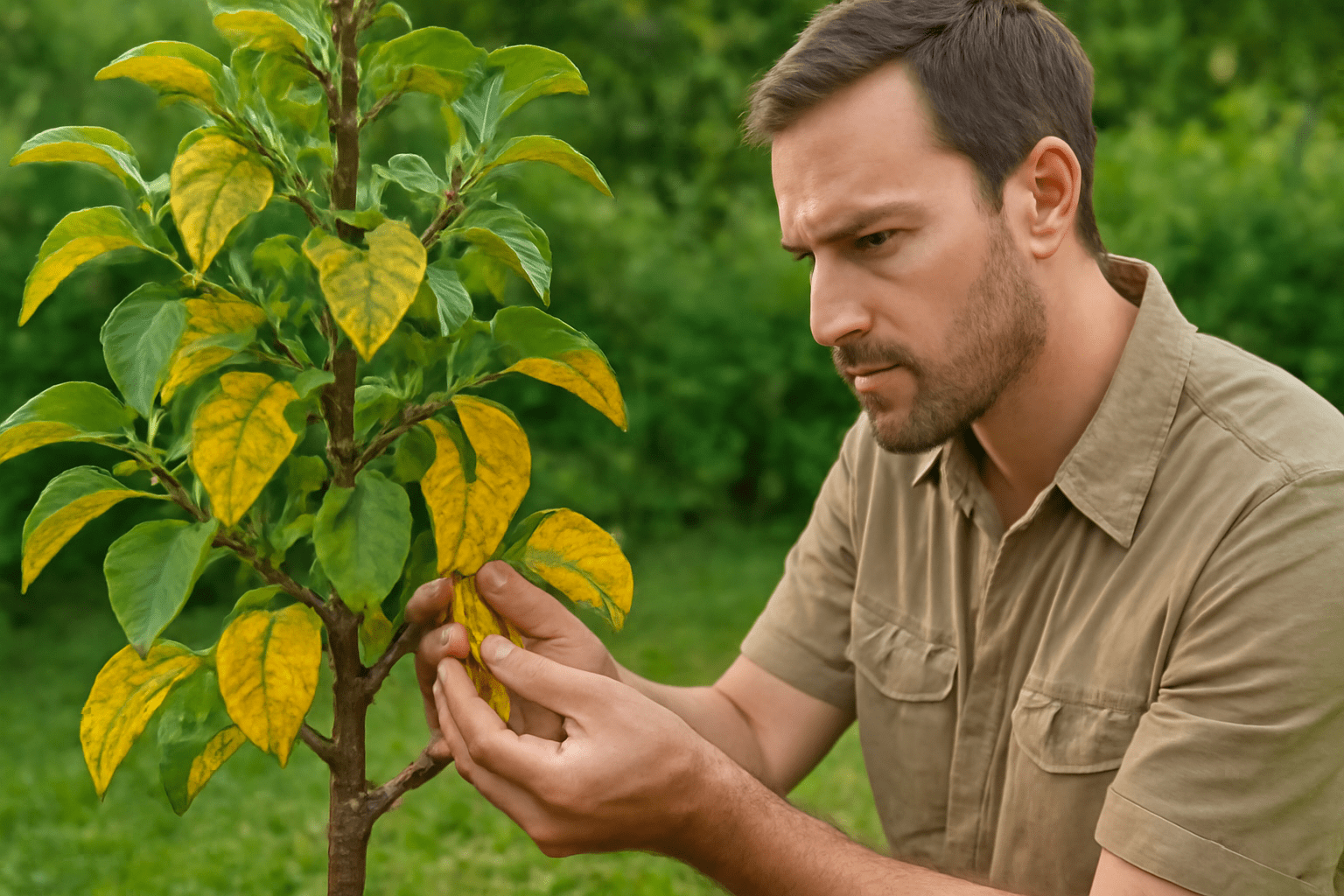
🍂 Yellowing Leaves 🍂
🧐 What It Means 🧐
Yellowing leaves 🍃 on your dwarf apple tree 🌳 can be a sign of several issues. Most commonly, it indicates either nutrient deficiency 🧑🌾 or overwatering 💧. If the tree 🌳 is not getting the right nutrients or the soil is too soggy 🌊, the leaves 🍃 may turn yellow.
🍏 Solution 🍏
- Check the Soil: Ensure that your tree 🌳 is planted in well-draining soil 🌿. If the soil is too compact or doesn’t drain well, water 💦 can pool around the roots 🦶, causing them to rot.
- Fertilize: Apply a balanced fertilizer (like 10-10-10) in the spring 🌷 to replenish nutrients, but avoid overfertilizing 🌱, as this can cause further stress on your tree 🌳.
🍏 Lack of Fruit 🍏
🧐 What It Means 🧐
If your dwarf apple tree 🌳 isn’t producing fruit 🍏, the most likely culprits are inadequate pollination 🌸 or the tree 🌳 being too young to fruit 🍎. Dwarf apple trees typically begin producing fruit 🍏 in 2-3 years, so don’t panic 😱 if it’s still young. If the tree 🌳 is older, poor pollination 🌸 could be to blame.
🍏 Solution 🍏
- Check Pollination: Make sure you have a compatible apple tree 🌳 nearby for cross-pollination. Even self-pollinating trees 🌱 often benefit from another variety nearby to increase fruit yield 🍏.
- Give It Time: If your tree 🌳 is still young 🌱, give it a bit more time 🕒. With the right care 🌱, it should start producing fruit 🍏 soon! 🌸
🌱 Tree Not Growing Well 🌱
🧐 What It Means 🧐
If your dwarf apple tree 🌳 isn’t growing well 🌿, the issue could be due to pests 🐛, diseases 🦠, or poor soil conditions 🌍. These problems can slow growth ⏳ or stunt the tree’s overall health 🩺.
🍏 Solution 🍏
- Inspect for Pests and Diseases: Check your tree 🌳 regularly for signs of pests 🐜 like aphids 🦗, codling moths 🦋, or apple maggots 🐛. Also, look for any signs of disease 🦠 such as spots on the leaves 🍃 or mold 🦠.
- Improve Soil Quality: Ensure the soil 🌿 is well-drained and has a good balance of nutrients 💚. If needed, amend the soil with organic compost 🌱 or adjust the pH levels to make it more suitable for apple trees 🍏.
- Prune Dead Wood: Regularly prune ✂️ away dead or diseased branches 🌿 to allow the tree 🌳 to focus its energy on healthy growth 🌱.
📌 Quick Tips for Troubleshooting 📌
- Yellowing Leaves: Check soil drainage 🌱 and fertilize with a balanced fertilizer 🌿 to correct nutrient deficiencies 🍏.
- Lack of Fruit: Ensure good pollination 🌸 by planting a compatible pollinator 🌳 nearby or be patient 🕒 if the tree 🌳 is still young.
- Tree Not Growing Well: Look for pests 🐛, diseases 🦠, or soil issues 🌱. Improve the soil 🌿, prune dead wood 🌿, and treat for pests 🐜 if necessary.
By staying vigilant 👀 and addressing any issues early 🔧, you can help your dwarf apple tree 🌳 stay healthy 🌱 and productive 🍏. Troubleshooting these common problems will ensure that your tree 🌳 thrives for years to come, giving you a beautiful, fruitful garden 🌳🍏!
🍏 Final Thoughts 🌳
Growing dwarf apple trees 🌳 is a rewarding experience that brings the joy of homegrown fruit 🍏 right to your doorstep—even if you have limited space 🏡. With the right care 🌱, attention 🧐, and a little patience ⏳, your dwarf apple tree 🌳 can thrive, providing you with delicious apples 🍏 year after year. Whether you’re a beginner 🌱 or a seasoned gardener 👩🌾, the tips and solutions shared here will help you avoid common pitfalls 🚧 and maximize your tree’s potential 🌳.
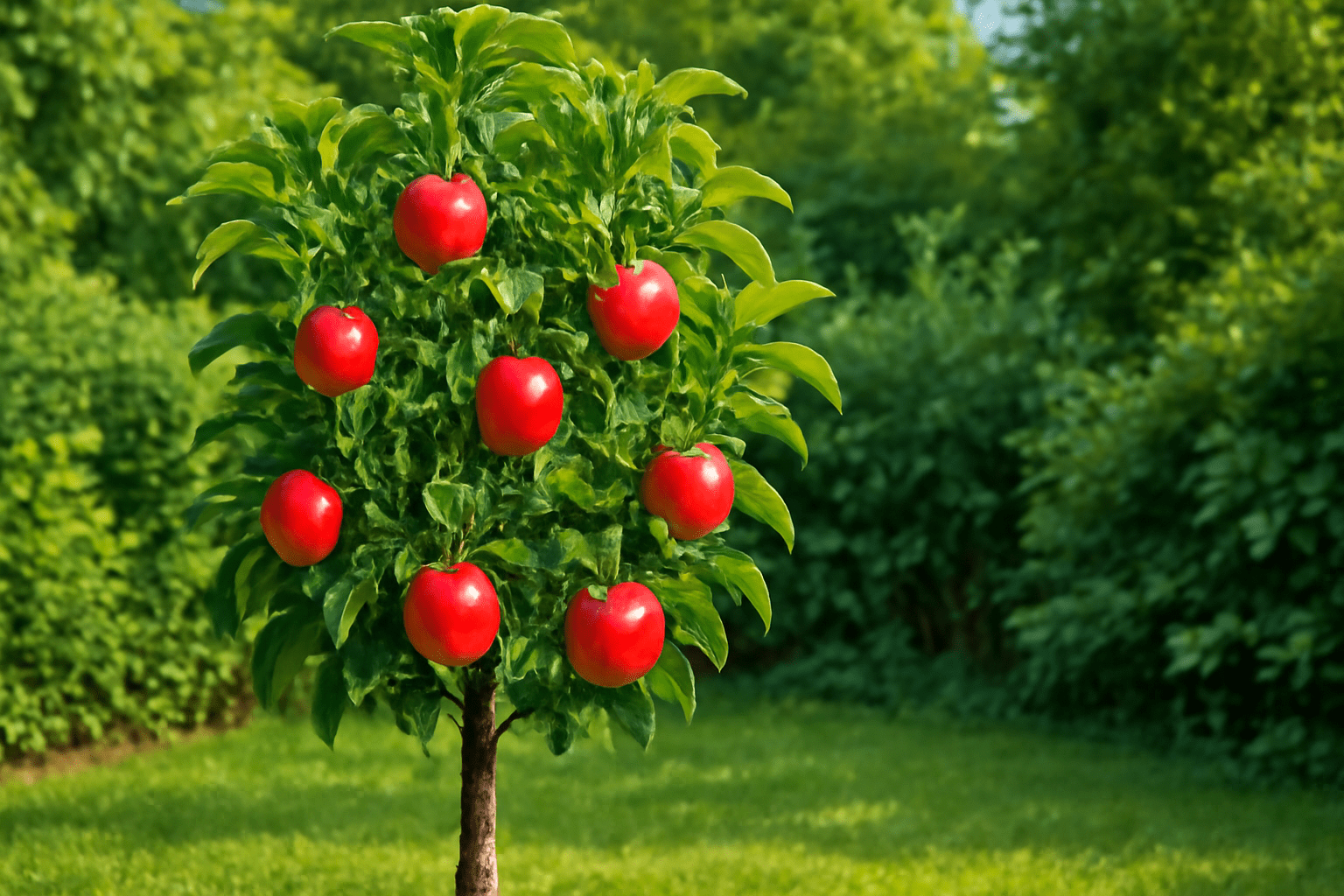
From choosing the right variety 🍏 to understanding the pollination process 🌸 and troubleshooting common issues 🛠️, you’re now equipped with the knowledge 📚 you need to grow a healthy 🌱, productive dwarf apple tree 🍏.
So, what are you waiting for? Grab your gardening tools 🧑🌾, plant your tree 🌳, and enjoy the satisfaction 😊 of harvesting your very own apples 🍏—fresh, sweet 🍯, and full of flavor! 🍏🌳 Happy gardening! 🌱
Frequently Asked Questions (FAQ)
How much space do dwarf apple trees need?
Dwarf apple trees are perfect for small spaces, typically growing to 6-8 feet tall. They require at least 6-8 hours of direct sunlight and well-drained soil. Even in small gardens or patios, they can thrive as long as they have enough space for proper air circulation.
How long does it take for dwarf apple trees to bear fruit?
Most dwarf apple trees begin to produce fruit in 2–3 years, much faster than standard apple trees. Be patient, as the first harvest may be small, but with proper care, your tree will start yielding larger amounts of fruit in subsequent years. 🍏
Do I need more than one dwarf apple tree for pollination?
Some dwarf apple trees are self-pollinating, but many varieties require cross-pollination to produce fruit. Planting a second compatible apple tree nearby can increase the fruit yield and quality. Always check your tree’s pollination needs before planting. 🌸
How often should I water my dwarf apple tree?
Water your dwarf apple tree deeply once a week, especially during dry spells. Ensure the soil is moist but not soggy—good drainage is crucial to avoid root rot. During hotter months, you may need to water more frequently. 🌞
When is the best time to prune a dwarf apple tree?
Prune your dwarf apple tree late winter or early spring while it is still dormant. This helps remove dead or diseased wood and encourages strong new growth. Regular pruning also keeps the tree’s shape and ensures better airflow. ✂️
Why are the leaves of my dwarf apple tree turning yellow?
Yellowing leaves can be caused by nutrient deficiencies or overwatering. Ensure your tree is planted in well-draining soil and use a balanced fertilizer to provide essential nutrients. Avoid overwatering, as it can cause root rot. 🌱
What should I do if my dwarf apple tree isn’t producing fruit?
If your tree isn’t bearing fruit, it might be due to inadequate pollination or the tree being too young. Ensure a compatible pollinator tree is nearby or give the tree more time if it’s still young. If it’s older, inspect for pests or diseases. 🌳
How do I protect my dwarf apple tree from pests and diseases?
Regularly inspect your tree for pests like aphids, codling moths, or diseases like apple scab. Use organic treatments like neem oil or insecticidal soap to control infestations. Ensure good airflow and proper spacing to reduce disease risks. 🌿
